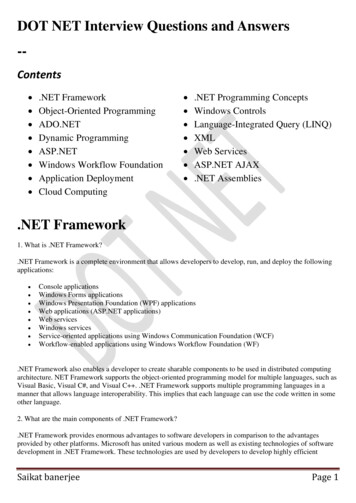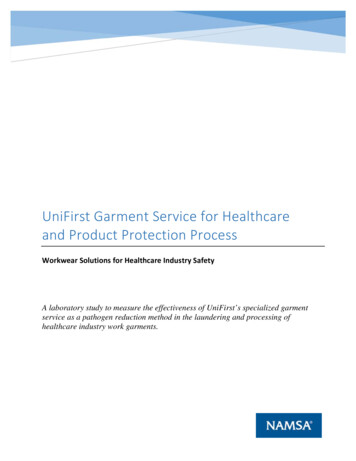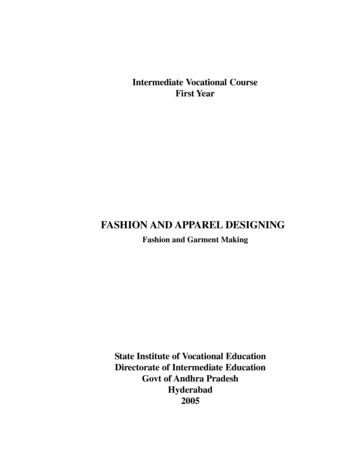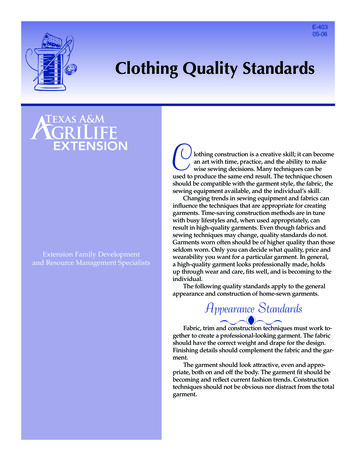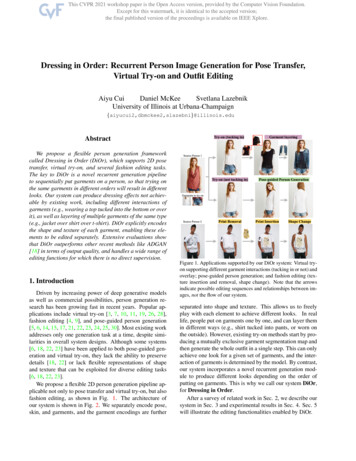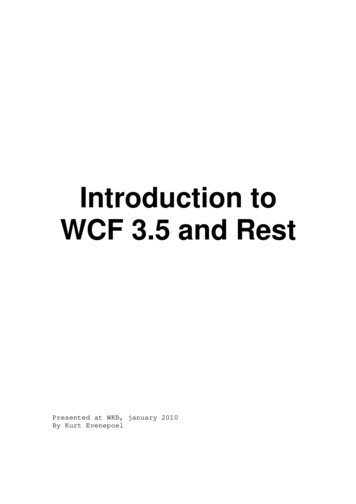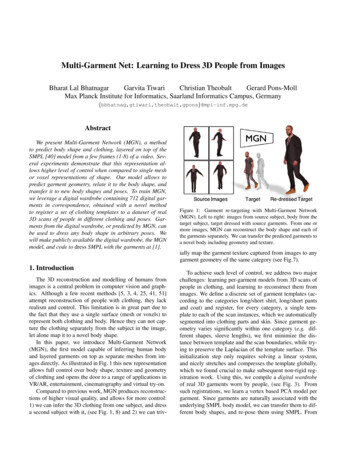
Transcription
Multi-Garment Net: Learning to Dress 3D People from ImagesBharat Lal BhatnagarGarvita TiwariChristian TheobaltGerard Pons-MollMax Planck Institute for Informatics, Saarland Informatics Campus, pg.deAbstractWe present Multi-Garment Network (MGN), a methodto predict body shape and clothing, layered on top of theSMPL [40] model from a few frames (1-8) of a video. Several experiments demonstrate that this representation allows higher level of control when compared to single meshor voxel representations of shape. Our model allows topredict garment geometry, relate it to the body shape, andtransfer it to new body shapes and poses. To train MGN,we leverage a digital wardrobe containing 712 digital garments in correspondence, obtained with a novel methodto register a set of clothing templates to a dataset of real3D scans of people in different clothing and poses. Garments from the digital wardrobe, or predicted by MGN, canbe used to dress any body shape in arbitrary poses. Wewill make publicly available the digital wardrobe, the MGNmodel, and code to dress SMPL with the garments at [1].Figure 1: Garment re-targeting with Multi-Garment Network(MGN). Left to right: images from source subject, body from thetarget subject, target dressed with source garments. From one ormore images, MGN can reconstruct the body shape and each ofthe garments separately. We can transfer the predicted garments toa novel body including geometry and texture.ially map the garment texture captured from images to anygarment geometry of the same category (see Fig.7).1. IntroductionThe 3D reconstruction and modelling of humans fromimages is a central problem in computer vision and graphics. Although a few recent methods [5, 3, 4, 25, 41, 51]attempt reconstruction of people with clothing, they lackrealism and control. This limitation is in great part due tothe fact that they use a single surface (mesh or voxels) torepresent both clothing and body. Hence they can not capture the clothing separately from the subject in the image,let alone map it to a novel body shape.In this paper, we introduce Multi-Garment Network(MGN), the first model capable of inferring human bodyand layered garments on top as separate meshes from images directly. As illustrated in Fig. 1 this new representationallows full control over body shape, texture and geometryof clothing and opens the door to a range of applications inVR/AR, entertainment, cinematography and virtual try-on.Compared to previous work, MGN produces reconstructions of higher visual quality, and allows for more control:1) we can infer the 3D clothing from one subject, and dressa second subject with it, (see Fig. 1, 8) and 2) we can triv-To achieve such level of control, we address two majorchallenges: learning per-garment models from 3D scans ofpeople in clothing, and learning to reconstruct them fromimages. We define a discrete set of garment templates (according to the categories long/short shirt, long/short pantsand coat) and register, for every category, a single template to each of the scan instances, which we automaticallysegmented into clothing parts and skin. Since garment geometry varies significantly within one category (e.g. different shapes, sleeve lengths), we first minimize the distance between template and the scan boundaries, while trying to preserve the Laplacian of the template surface. Thisinitialization step only requires solving a linear system,and nicely stretches and compresses the template globally,which we found crucial to make subsequent non-rigid registration work. Using this, we compile a digital wardrobeof real 3D garments worn by people, (see Fig. 3). Fromsuch registrations, we learn a vertex based PCA model pergarment. Since garments are naturally associated with theunderlying SMPL body model, we can transfer them to different body shapes, and re-pose them using SMPL. From
Prediction, apePredictedBodyPoseeCombine and Re-posSegmentation2D JointsInput ImagesPredict clothingSelf Supervision:2D Segmentation Loss-3D Supervision:Vertex LossIntermediateLossesPose, Shape, Translation,Garment parametersFigure 2: Overview of our approach. Given a small number of RGB frames (currently 8), we pre-compute semantically segmented images(I) and 2D Joints (J ). Our Multi-Garment Network (MGN), takes {I, J } as input and infers separable garments and the underlyinghuman shape in a canonical pose. We repose these predictions using our per-frame pose predictions. We train MGN with a combination of2D and 3D supervision. The 2D supervision can be used for online refinement at test time.the digital wardrobe, MGN is trained to predict, given oneor more images of the person, the body pose and shapeparameters, the PCA coefficients of each of the garments,and a displacement field on top of PCA that encodes clothing detail. At test time, we refine this bottom-up estimateswith a new top-down objective that forces projected garments and skin to explain the input semantic segmentation.This allows more fine-grained image matching as comparedto standard silhouette matching. Our contributions can besummarized as: A novel data driven method to infer, for the first time,separate body shape and clothing from just images (fewRGB images of a person rotating in front of the camera). A robust pipeline for 3D scan segmentation and registration of garments. To the best of our knowledge, there areno existing works capable of automatically registering asingle garment template set to multiple scans of real people with clothing. A novel top-down objective function that forces the predicted garments and body to fit the input semantic segmentation images. We demonstrate several applications that were not previously possible such as dressing avatars with predicted3D garments from images, and transfer of garment texture and geometry. We will make publicly available the MGN to predict 3Dclothing from images, the digital wardrobe, as well ascode to “dress” SMPL with it.2. Related WorkIn this section we discuss the two branches of work mostrelated to our method, namely capture of clothing and bodyshape and data-driven clothing models.Performance Capture. The classical approach to bring dy-namic sequences into correspondence is to deform meshesnon-rigidly [11, 18, 10] or volumetric shape representations [28, 2] to fit multiple image silhouettes. Without apre-scanned template, fusion [30, 29, 55, 43, 58] trackers incrementally fuse geometry and appearance [66] to build thetemplate on the fly. Although flexible, these require multiview [57, 37, 14], one or more depth cameras [19, 45], orrequire the subject to stand still while turning the camerasaround them [53, 38, 63, 16]. From RGB video, Habermannet al.[25] introduced a real time tracking system to capturenon-rigid clothing dynamics. Very recently, SimulCap [59]allows multi-part tracking of human performances from adepth camera.Body and cloth capture from images and depth. Sincecurrent statistical models can not represent clothing, mostworks [7, 26, 40, 68, 48, 32, 22, 67, 31, 50, 8, 33, 44, 46]are restricted to inferring body shape alone. Model fits havebeen used to virtually dress and manipulate people’s shapeand clothing in images [50, 67, 62, 36]. None of these approaches recover 3D clothing. Estimating body shape andclothing from an image has been attempted in [24, 12], butit does not separate clothing from body and requires manual intervention [65, 49] . Given a depth camera, Chen etal. [13] retrieve similar looking synthetic clothing templatesfrom a database. Daněřek et al. [9] use physics based simulation to train a CNN but do not estimate garment and bodyjointly, require pre-specified garment type, and the resultscan only be as good as the synthetic data.Closer to ours is the work of Alldieck et al. [3, 5, 6]which reconstructs, from a single image or a video, clothing and hair as displacements on top of SMPL, but can notseparate garments from body, and can not transfer clothing to new subjects. In stark contrast to [3], we registerthe scan garments (matching boundaries) and body separately, which allows us to learn the mapping from images toa multi-layer representation of people.Data-driven clothing. A common strategy to learn ef-
ficient data-driven models is to use off-line simulations[17, 34, 21, 54, 52, 23] for generating data. These approaches often lack realism when compared to modelstrained using real data. Very few approaches have shownmodels learned from real data. Given a dynamic scan sequence, Neophytou et al.[42] learn a two layer model (bodyand clothing) and use it to dress novel shapes. A similarmodel has been recently proposed [61], where the clothinglayer is associated to the body in a fuzzy fashion. Othermethods [60, 64] focus explicitly on estimating the bodyshape under clothing. Like these methods, we treat the underlying body shape as a layer, but unlike them, we segment out the different garments allowing sharp boundariesand more control. For garment registration, we build on theideas of ClothCap [47], which can register a subject specific multi-part model to a 4D scan sequence. By contrast,we register a single template set to multiple scan instances–varying in garment geometry, subject identity and pose,which requires a new solution. Most importantly, unlike allprevious work [35, 47, 61], we learn per-garment modelsand train a CNN to predict body shape and garment geometry directly from images.3. MethodIn order to learn a model to predict body shape and garment geometry directly from images, we process a datasetof 356 scans of people in varied clothing, poses and shapes.Our data pre-processing (Sec. 3.1) consists of the following steps: SMPL registration to the scans, body aware scansegmentation and template registration. We obtain, for every scan, the underlying body shape, and the garments ofthe person registered to one of the 5 garment template categories: shirt, t-shirt, coat, short-pants, long-pants. Theobtained digital wardrobe is illustrated in Fig. 3. The garment templates are defined as regions on the SMPL surface;the original shape follows a human body, but it deforms tofit each of the scan instances after registration. Since garment registrations are naturally associated to the body represented with SMPL, they can be easily reposed to arbitraryposes. With this data, we train our Multi-Garment Networkto estimate the body shape and garments from one or moreimages of a person, see Sec. 3.2.3.1. Data Pre-Processing: Scan Segmentation andRegistrationUnlike ClothCap [47] which registers a template to a 4Dscan sequence of a single subject, our task is to register single template across instances of varying styles, geometries,body shapes and poses. Since our registration follows theideas of [47], we describe the main differences here.Body-Aware Scan Segmentation We first automaticallysegment the scans into three regions: skin, upper-clothesand pants (we annotate the garments present for every scan).Since even SOTA image semantic segmentation [20] is inaccurate, naive lifting to 3D is not sufficient. Hence, we incorporate body specific garment priors and segment scansby solving an MRF on the UV-map of the SMPL surfaceafter non-rigid alignment.A garment prior (for garment g) derives from a set oflabels lig {0, 1} indicating the vertices vi S of SMPLthat are likely to overlap with the garment. The aim is to penalize labelling vertices as g outside this region, see Fig 4.Since garment geometry varies significantly within one category (e.g. t-shirts of different sleeve lengths), we define acost increasing with the geodesic distance distgeo (v) : S 7 R from the garment region boundary – efficiently computedbased on heat flow [15]. Conversely, we define a similarpenalty for labeling vertices in the garment region with alabel different than g. As data terms, we incorporate CNNbased semantic segmentation [20], and appearance termsbased Gaussian Mixture Models in La color space. The influence of each term is illustrated in Fig. 4, for more detailswe refer to the supp. mat.After solving the MRF on the SMPL UV map, we cansegment the scans into 3 parts by transferring the labelsfrom the SMPL registration to the scan.Garment Template We build our garment template ontop of SMPL D, M (·), which represents the human bodyas a parametric function of pose(θ), shape(β), globaltranslation(t) and optional per-vertex displacements (D):M (β, θ, D) W (T (β, θ, D), J(β), θ, W)(1)T (β, θ, D) T Bs (β) Bp (θ) D.(2)The basic principle of SMPL is to apply a series of lineardisplacements to a base mesh T with n vertices in a T-pose,and then apply standard skinning W (·). Specifically, Bp (·)models pose-dependent deformations of a skeleton J, andBs (·) models the shape dependent deformations. W represents the blend weights.For each garment class g we define a template mesh,Gg in T-pose, which we subsequently register to explainthe scan garments. We define Ig Zmg n as an indicatormatrix, with Igi,j 1 if garment g vertex i {1 . . . mg } isassociated with body shape vertex j {1 . . . n}. In our experiments, we associate a single body shape vertex to eachgarment vertex. We compute displacements to the corresponding SMPL body shape β g under the garment asDg Gg Ig T (β g , 0θ , 0D )(3)Consequently, we can obtain the garment shape (unposed),T g for a new shape β and pose θ asT g (β, θ, Dg ) Ig T (β, θ, 0) Dg(4)To pose the vertices of a garment, each vertex uses the skinning function in Eq. 1 of the associated SMPL body vertex.G(β, θ, Dg ) W (T g (β, θ, Dg ), J(β), θ, W)(5)
Figure 3: Digital 3D wardrobe. We use our proposed multi-mesh registration approach to register garments present in the scans (left) tofixed garment templates. This allows us to build a digital wardrobe and dress arbitrary subjects (center) by picking the garments (marked)from the wardrobe.q1:C {q1 , . . . , qC } with corresponding template vertexindices j1:C . Let IC mg be a selector matrix indicating theindices in the template corresponding to each qi . With this,we minimize the following least squares problem: Lg initGg (6)wIC mgwq1:CFigure 4: Left to right: Scan, segmentation with MRF and CNNunaries, MRF with CNN unaries garment prior appearanceterms, the garment(t-shirt) prior based on geodesics and the template. Notice how the garment prior is crucial to obtain robustresults.Garment Registration Given the segmented scans, wenon-rigidly register the body and garment templates (upperclothes, lower-clothes) to scans using the multi-part alignment proposed in [47]. The challenging part is that garmentgeometries vary significantly across instances, which makesthe multi-part registration fail (see supplementary). Hence,we first initialize by deforming the vertices of each garmenttemplate with the shape and pose of SMPL registrations,obtaining deformed vertices Gginit . Note that since the vertices defining each garment template are fixed, the clothingboundaries of the initially deformed garment template willnot match the scan boundaries. In order to globally deformthe template to match the clothing boundaries in a singleshot, we define an objective function based on Laplaciandeformation [56].Let Lg Rmg mg be the graph Laplacian of the garment mesh, and init Rmg 3 the differential coordinates of the initially deformed garment template init L Gginit . For every vertex si Sb in a scan boundarySb , we find its closest vertex in the corresponding template garment boundary, obtaining a matrix of scan pointswith respect to the template garment vertices Gg , where thefirst block Lg Gg init forces the solution to keep the local surface structure, while the second block wIC mg Gg wq1:C makes the boundaries match. The nice property ofthe linear system solve is that the garment template globallystretches or compresses to match the scan garment boundaries, which would take many iterations of non-linear nonrigid registration [47] with the risk of converging to bad local minima. After this initialization, we non-linearly register each garment Gg to fit the scan surface. We build ontop of the proposed multi-part registration in [47] and propose additional loss terms on garment vertices, vk Gg , tofacilitate better garment unposing, Eunpose , and minimizeinterpenetration, Einterp , with the underlying SMPL bodysurface, S.X XEinterp d(vk , S)(7)g(d(x, S) vk Gg0,if x outside Sw x y 2 , if x inside S(8)where w is a constant (w 25 in our experiments), vk isthe k th vertex of Gg and y is the point closest to x on S.Our garment formulation allows us to freely repose thegarment vertices. We can use this to our advantage for applications such as animating clothed virtual avatars, garment re-targeting etc. However, posing is highly nonlinear and can lead to undesired artefacts, specially when retargeting garments across subjects with very different poses.
Since we re-target the garments in unposed space, we reduce distortion by forcing distances from garment verticesto the body to be preserved after unposing:X X(d(vk , S) d(vk0 , S 0 ))2 (9)Eunpose ging to 3D poseslP fwθ (I, J ),and to a common latent code corresponding to body shape(lβ ) and garments (lG ) by averaging the per frame codesvk Ggwhere d(x, S) is the L2 distance between point x and surface S. vk0 and S 0 denote garment vertex and body surfacein unposed space, using Eq. 5 and 1 respectively.Dressing SMPL The SMPL model has proven very useful for modelling unclothed shapes. Our idea is to builda wardrobe of digital clothing compatible with SMPL tomodel clothed subjects. To this end we propose a simpleextension that allows to dress SMPL. Given a garment Gg ,we use Eq. 3, 4, 5 to pose and skin the garment vertices.The dressed body including body shape (encoded as G1 )will be given by stacking the L individual garment vertices [G1 (β, θ, D1 )T , . . . , GL (β, θ, DL )T ]T . We definethe function C(θ, β, D) which returns the posed and shapedvertices for the skin, and each of the garments combined.See Fig. 5 and supplementary for results on re-targetinggarments using MGN across different SMPL bodies.3.2. From Images to GarmentsFrom registrations, we learn a shape space of garments,and generate a synthetic training dataset with pairs of images and body 3D garment pairs. From this data we trainMGN:Multi-Garment Net, which maps images to 3D garments and body shape.Garment Shape Space In order to factor out pose deformations from garment shape, we “unpose” the j th garmentregistrations Ggj Rmg 3 , similar to [64, 47]. Since thegarments of each category are all in correspondence, we caneasily compute PCA directly on the unposed vertices to obtain pose-invariant shape basis (Bg ). Using this, we encode a garment shape using 35 components z g R35 , plusga residual vector of offsets Dhf,gj , mathematically: Gj Bg zgj Dhf,gj . From each scan, we also extract the bodyshape under clothing similarly as in [64], which is essentialto re-target a garment from one body to another.MGN: Multi-Garment Net The input to the modelis a set of semantically segmented images, I {I0 , I1 , ., IF 1}, and corresponding 2D joint estimates,J {J0 , J1 , ., JF 1}, where F is the number of imagesused to make the prediction. Following [20, 3], we abstractaway the appearance information in RGB images and extract semantic garment segmentation [20] to reduce the riskof over-fitting, albeit at the cost of disregarding useful shading signal. For simplicity, let now θ denote both the jointangles θ and translation t.The base network, fw , maps the 2D poses J , and imagesegmentations I, to per frame latent code (lP ) correspond-(10)lβ , lG F 11 X β,Gfw (If , Jf ).F(11)f 0For each garment class, we train separate branches,Mwg (·), to map the latent code lG to the un-posed garmentGg , which itself is reconstructed from low-frequency PCAcoefficients zg , plus Dhf,g encoding high-frequency displacementsMwg (lG , Bg ) Gg Bg z g Dhf,g .(12)From the shape and pose latent codes lβ , lθ , we predictbody shape parameters β and pose θ respectively, using afully connected layer. Using the predicted body shape βand geometry Mwg (lG , Bg ) we compute displacements as inEq. 3:Dg Mwg (lG , Bg ) Ig T (β, 0θ , 0D ).(13)Consequently, the final predicted 3D vertices posed for thef th frame are obtained with C(β, θ f , D), from which werender 2D segmentation masksRf R(C(β, θ f , D), c),(14)where R(·) is a differentiable renderer [27], Rf the rendered semantic segmentation image for frame f , and c denotes the camera parameters that are assumed fixed whilethe person moves. The rendering layer in Eq. (14) allowsus to compare predictions against the input images. SinceMGN predicts body and garments separately, we can predict a semantic segmentation image, leading to a more finegrained 2D loss, which is not possible using a single meshsurface representation [3]. Note that Eq. 14 allows to trainwith self-supervision.3.3. Loss functionsThe proposed approach can be trained with 3D supervision on vertex coordinates, and with self supervision inthe form of 2D segmented images. We use upper-hat forvariables that are known and used for supervision duringtraining. We use the following losses to train the network inan end to end fashion: 3D vertex loss in the canonical T-pose (θ 0θ ):2L3D0θ C(β, 0θ , D) C(β̂, 0θ , D̂) ,(15)where, 0θ represents zero-vector corresponding to zeropose.
Figure 5: Dressing SMPL with just images. We use MGN to extract garments from the images of a source subject (middle) and use theinferred 3D garments to dress arbitrary human bodies in various poses from SMPL shape subjects. The two sets correspond to male (left)and female (right) body shapes respectively. 3D vertex loss in posed space:L3DP F 1X C(β, θ f , D) C(β̂, θ̂ f , D̂) 2(16)f 0 2D segmentation loss: Unlike [3] we do not optimize silhouette overlap, instead we jointly optimize the projectedper-garment segmentation against the input segmentationmask. This ensures that each garment explains its corresponding mask in the image:L2Dseg F 1X Rf If 2 ,(17)f 0 Intermediate losses: We further impose losses on intermediate Ppose, shape and garment parameter predictions:F 1Lθ θ̂ f θ f 2 , Lβ β̂ β 2 , Lz PL 1 gf 0 g 2g 0 ẑ z where F, L are the number of imagesand garments respectively. ẑ are the ground truth PCAgarment parameters. While such losses are a bit redundant, they stabilize learning.3.4. Implementation detailsBase Network (fw ): We use a CNN to map the input set{I, J } to the body shape, pose and garment latent spaces. Itconsists of five, 2D convolutions followed by max-poolinglayers. Translation invariance, unfortunately, renders CNNsunable to capture the location information of the features.In order to reproduce garment details in 3D, it is important to leverage 2D features as well as their location in the2D image. To this end, we adopt a strategy similar to [39],where we append the pixel coordinates to the output of every CNN layer. We split the last convolutional feature mapsinto three parts to individuate the body shape, pose and garment information. The three branches are flattened out andwe append 2D joint estimates to the pose branch. Threefully connected layers and average pooling on garment andshape latent codes, generate lβ , lθ and lG respectively. Seesupplementary for more details.Garment Network (Mwg ): We train separate garment networks for each of the garment classes. The garment networkconsists of two branches. The first predicts the overall meshshape, and second one adds high frequency details. Fromthe garment latent code (lG ), the first branch, consisting oftwo fully connected layers (sizes 1024, 128), regresses thePCA coefficients. Dot product of these coefficients with thePCA basis generates the base garment mesh. We use thesecond fully connected branch (size mg ) to regress displacements on top of the mesh predicted in the first branch.We restrict these displacements to 1cm to ensure thatoverall shape is explained by the PCA mesh and not thesedisplacements.4. Dataset and ExperimentsDataset We use 356 3D scans of people with various bodyshapes, poses and in diverse clothing. We held out 70 scansfor testing and use the rest for training. Similar to [3, 5], wealso restrict our setting to the scenario where the person isturning around in front of the camera. We register the scansusing multi-mesh registration, SMPL G. This enables further data augmentation since the registered scans can nowbe re-posed and re-shaped.We adopt the data pre-processing steps from [3] includingthe rendering and segmentation. We also acknowledge thescale ambiguity primarily present between the object sizeand the distance to the camera. Hence we assume that thesubjects in 3D have a fixed height and regress their distancefrom the camera. Same as [3], we also ignore the effect ofcamera intrinsics.4.1. ExperimentsIn this section we discuss the merits of our approach bothqualitatively and quantitatively. We also show real worldapplications in the form of texture transfer (Fig. 7), where
Figure 6: Qualitative comparison with Alldieck et al.[3]. In each set we visualize 3D predictions from [3](left) and our method (right) forfive test subjects. Since our approach explicitly models garment geometry, it preserves more garment details, as is evident from minimaldistortions across all the subjects. For more results see supplementary.Figure 7: Texture transfer. We model each garment class as a mesh with fixed topology and surface parameterization. This enables us totransfer texture from any garment to any other registered instance of the same class. The first column shows the source garment mesh,while the subsequent images show original and transferred garment texture registrations.we maintain the original geometry of the source garmentbut map novel texture. We also show garment re-targetingfrom images using MGN in Fig. 8.Qualitative comparisons: We compare our method against[3] on our scan dataset. For fair comparison we re-train themodels proposed by Alldieck et al.[3] on our dataset andcompare against our approach (Dataset used by [3] is notpublicly available). Figure 6 indicates the advantage of incorporating the garment model in structured prediction oversimply modelling free form displacements. Explicit garment modelling allows us to predict sharper garment boundaries and minimize distortions (see Fig. 6). More examplesare shown in the supplementary material.Quantitative Comparison: In this experiment we do aquantitative analysis of our approach against the state of theart 3D prediction method, [3]. We compute a symmetric error between the predicted and GT garment surfaces similarto [3]. We report per-garment error, E g (supplementary),and overall error, i.e. mean of E g over all the garments N Eg 1 XN i 11 X1 Xd(vk , Sig ) gd(vk , Ŝig ) ,g Si Ŝi ggv Svk Ŝiki(18)where N is the number of meshes with garment g. Sgi andSig denote the set of vertices and the surface of the ith predicted mesh respectively, belonging to garment g. Operator(.̂) denotes GT values. d(vk , S) computes the L2 distancebetween the vertex vk and surface S.This criterion is slightly different than [3] because wedo not evaluate error on the skin parts. We reconstructthe 3D garments with mean vertex-to-surface error of 5.78mm with 8 frames as input. We re-train octopus [3] on ourdataset and the resulting error is 5.72mm.We acknowledge the slightly better performance of [3]and attribute it to the fact that the single mesh based approaches do not bind vertices to semantic roles, i.e these approaches can pull vertices from any part of the mesh to explain 3D deformations where as our approach ensures thatonly semantically correct vertices explain the 3D shape.It is also worth noting that MGN predicts garments aslinear function (PCA coefficients) of latent code, whereas[3] deploys GraphCNN. PCA based formulation thougheasily tractable is inherently biased towards smooth results.Our work paves the way for further exploration into building garment models for modelling the variations in garmentgeometry over a fixed topology.We report the results for using varying number of framesin the supplementary.
Figure 8: Garment re-targeting by MGN using 8 RGB images. In each of the three sets we show the source subject, target subject andre-targeted garments. Using MGN, we can re-target garments including both texture and geometry.GT vs Predicted pose: The 3D vertex predictions are afunction of pose and shape. In this experiment we do anablation study to isolate the effect of errors in pose estimation on vertex predictions. This experiment is important tobetter understand the strengths and weaknesses of the proposed approach in shape estimation by marginalizing overthe errors due to pose fitting. We study two scenarios, firstwhere we predict the 3D pose and second, where we haveaccess to GT pose. We report mean vertex-to-surface errorof 5.78mm with GT poses and 11.90mm with our predictedposes.4.2. Re-targetingOur multi-mesh representation essentially decouples theunderlying body and the garments. This opens up an interesting possibility to take garments from source subject andvirtually dress a novel subject. Since the source and the target subjects could be in different poses, we first unpose thesource body and garments along with the target body. Wedrop the (.)0 notation for the unposed space in the followingsection for clarity. Below we propose and compare two garment re-targeting approaches. After re-targeting the targetbody and re-targeted garments are re-posed to their originalposes.Naive re-targeting: The simplest approach to re-targetclothes from source to target is to extract the garment offsets, Ds,g from the source subject usin
be used to dress any body shape in arbitrary poses. We will make publicly available the digital wardrobe, the MGN model, and code to dress SMPL with the garments at [1]. 1. Introduction The 3D reconstruction and modelling of humans from images is a central problem in computer vision and graph-ics. Although a few recent methods [5, 3, 4, 25, 41, 51]

